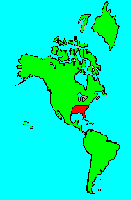SPECIES INFO
West Virginia bur-reed (Sparganium chlorocarpum) is a very local and rare species found in West Virginia south into North Carolina. This plant is similar to Sparganium americanum, but is smaller. The shiny seeds are dotted with red glands. The Carolina Flora says this is valid. (Kartesz moves Sparganium chlorocarpum (New York to Iowa) into S. erectum.)
Here we show the Britton and Brown image for Sparganium chlorocarpum, but note we are unsure whether this is S. chlorocarpum or Sparganium erectum.Sparganium genus is found in temperate regions of the world. This genus contains marsh and pond plants that can be erect or floating. The leaves are alternate and somewhat linear and sheathing at the base. There is considerable confusion in the precise naming of several of the forms. There are about 15 species.
Burr Reed Family (Sparganiaceae) has one genus with less than twenty-five species. There are now nine species growing in greater North America, including Puerto Rico, the Virgin Islands, Hawaii, and Greenland. These nine species are frequently difficult to separate; seed shape is frequently used. These plants are aquatic perennial herbs with linear leaves. The flowers are in globose clusters. The fruits are in rounded heads.
Pandanales order is considered the most primitive of the Monocots. The order contains three families, including the well-known cattail family. The bur-reeds and screw-pines belong here also. (Various scientists divide this order in different manners.)
Monocots are a large group of plants usually characterized by having leaves with parallel veins and a seed with a single shell. Most flowers are created with multiples of three. In the older botany texts, the Monocots were considered more primitive than the Dicots. However, many recent authors have placed the Monocots as an offshoot of the primitive Dicots. Here they are placed before the Dicots.
In l951 Lawrence at Cornell published a very detailed plant taxonomy for vascular plants. His taxonomy is very useful as he provided both a detailed explanation and also covered many genera. In the l990s Cronquist published a new plant taxonomy that improved the older taxonomy based on new knowledge. About the same time, Dahlgren published a different taxonomy.
Seed plants (Phylum Embryophyta) are generally grouped into one large phylum containing three major classes: the Gymnosperms, the Monocots, and the Dicots. (Some scientists separate the Gymnosperms into a separate phylum and refer to the remaining plants as flowering plants or Angiospermae.)
For North American counts of the number of species in each genus and family, the primary reference has been John T. Kartesz, author of A Synonymized Checklist of the Vascular Flora of the United States, Canada, and Greenland (1994). The geographical scope of his lists include, as part of greater North America, Hawaii, Alaska, Greenland, Puerto Rico, and the Virgin Islands.
Kartesz lists 21,757 species of vascular plants comprising the ferns, gymnosperms and flowering plants as being found in greater North America (including Alaska, Hawaii, Greenland, Puerto Rico and the Virgin Islands.
There are estimates within the scientific world that about half of the listed North American seed plants were originally native with the balance being comprised of Eurasian and tropical plants that have become established.
Plant kingdom contains a large variety of different organisms including mosses, ferns, and seed plants. Most plants manufacture their energy from sunlight and water. Identification of many species is difficult in that most individual plants have characteristics that have variables based on soil moisture, soil chemistry, and sunlight.
Because of the difficulty in learning and identifying different plant groups, specialists have emerged that study only a limited group of plants. These specialists revise the taxonomy and give us detailed descriptions and ranges of the various species. Their results are published in technical journals and written with highly specialized words that apply to a specific group.
On the other hand, there are the nature publishers. These people and companies undertake the challenging task of trying to provide easy to use pictures and descriptions to identify those species.


